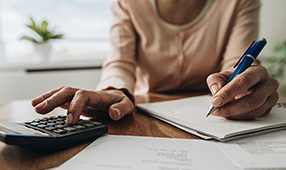Key takeaways
- Using credit cards for purchases and using ATMs to get local currency are the best options when abroad.
- Avoiding cash as much as possible won’t saddle you with extra unspent currency when you leave a country.
- If you don’t travel often, notify your card issuers before a trip abroad so that the unusual transactions don’t trigger a fraud alert that might freeze your account.
International networking of ATMs through MasterCard and Visa and the advent of smartphones have made paying for things abroad easier than ever. Smartphone apps, for instance, can do currency conversions for you and locate the nearest ATM that takes your card.
Using credit cards for purchases when possible and using ATMs to get local currency for when you need to pay cash are by far the best ways to pay for things when abroad because you will get the wholesale exchange rate rather than the less favorable retail rate posted in currency exchange facilities or at bank teller windows.
“I pay as much as I can with credit cards,” says Nicholas Kralev, founder of Kralev International, a travel advisory firm. “There are countries where I never use cash money.”
Kralev finds the extra fees entailed in ATM use—you pay fees to your bank and to the bank where you draw the money, as well as a separate fee for using your card abroad—add up to more than the percentage commission charged on credit card purchases in a foreign currency. In addition, he says, the exchange rate used in the credit card purchases is somehow “more wholesale” than that used for ATM withdrawals.
So this expert recommends using credit cards where possible, even for smaller transactions. That said, ATMs are the best way to get the cash you need. Travelers’ checks, the mainstay payment method for generations of Americans traveling abroad, have higher fees and usually are cashed for far less favorable exchange rates.
“People still use them, but they’re archaic,” says Kralev, who last used a travelers’ check in the 1990s.
Here are several other important don’ts for paying when abroad:
- Don’t exchange money before going abroad because the rates you get on foreign currency here are much more expensive. “Some people are afraid of the hassle” of arriving in a foreign country without the local currency, Kralev notes, and if cost savings is no object will want to have some money in their pocket when they step off the plane. But the hassle is not that great. There generally will be ATMs at the airport, or you can pay for the initial cab or transit ride with a credit card.
- Don’t change money at the exchange bureaus in the airport of your destination country. The rates are bad, and a commission generally is added on, too. Even if they claim there is no commission, there will be an extra charge built into the already bad rate of exchange.
- Don’t get a cash advance on your credit card. These generally carry a much higher interest rate than normal purchases. Under new credit card regulations, card issuers are now obliged to apply your payments to higher-rate balances first, but for every day that these charges stay on your account, you risk losing money, Kralev says.
- Don’t pay for purchases with dollars even if the merchant is willing to change the money for you, unless you are in one of the Caribbean countries where the local currency is on a fixed peg to the dollar. Otherwise, this will be the worst exchange rate of all.
One alternative at some of the up-market hotels is to get a cash advance in local currency from the front desk and have them add this to your bill, which you will pay with your credit card. This is useful, for instance, if you only need cash for a cab ride to dinner on a brief stay in a country.
Avoiding cash as much as possible has the advantage of not saddling you with extra unspent currency when you leave a country. This is less of an issue now in Europe because of the single currency, the euro, which you can continue to use as you travel from country to country. But you could still come back with odds and ends of British pounds, Swiss francs and Swedish kroner as well as euros. Even if you take the trouble to change these currencies back into dollars—which most people don’t—you lose money again on the second exchange transaction.
Travel advice websites such independenttraveler.com suggest a number of precautions to safeguard your credit and ATM cards, such as having their numbers and contact phone numbers written down with someone at home and/or with you in a place separate from where you keep the cards.
Some travelers go so far as to have a decoy wallet with a small amount of cash and expired credit cards to satisfy pickpockets and muggers. Others like to have some of those archaic travelers’ checks with them in case of loss or theft of valuables, because they can famously be replaced within 24 hours.
Experts also caution that the growing prevalence abroad of cards with an embedded microchip that require a pin can present difficulties to U.S. travelers with cards that have only a magnetic strip. This is especially true of automated purchases at train and subway stations and sometimes even at ATM machines.
Some U.S. banks like Citibank, Bank of America and Chase have started issuing dual cards with both the magnetic strip and embedded chip. The AAA Member Rewards Visa is available as a chip-and-pin card. Travelex has a prepaid chip-and-pin card that you can often buy at the airport before your departure, though the exchange rate may not be as good as on a credit card.
If you travel only rarely, you would be well advised to notify your card issuers before a trip abroad so that the unusual transactions don’t trigger a fraud alert that will freeze your account. Some travelers go so far as to have a decoy wallet with a small amount of cash and expired credit cards to satisfy pickpockets and muggers. Others like to have some of those archaic travelers’ checks with them in case of loss or theft of valuables because they can be replaced within 24 hours.
If you’re traveling to some exotic location off the beaten tourist track, you should research ahead of time whether it’s possible to use credit cards or ATMs there. “Do your homework,” Kralev says, for trips like these.
On the whole, though, for normal foreign travel to Europe, Asia and most countries in the American hemisphere, paying for things abroad is as simple as packing your wallet and taking off.












